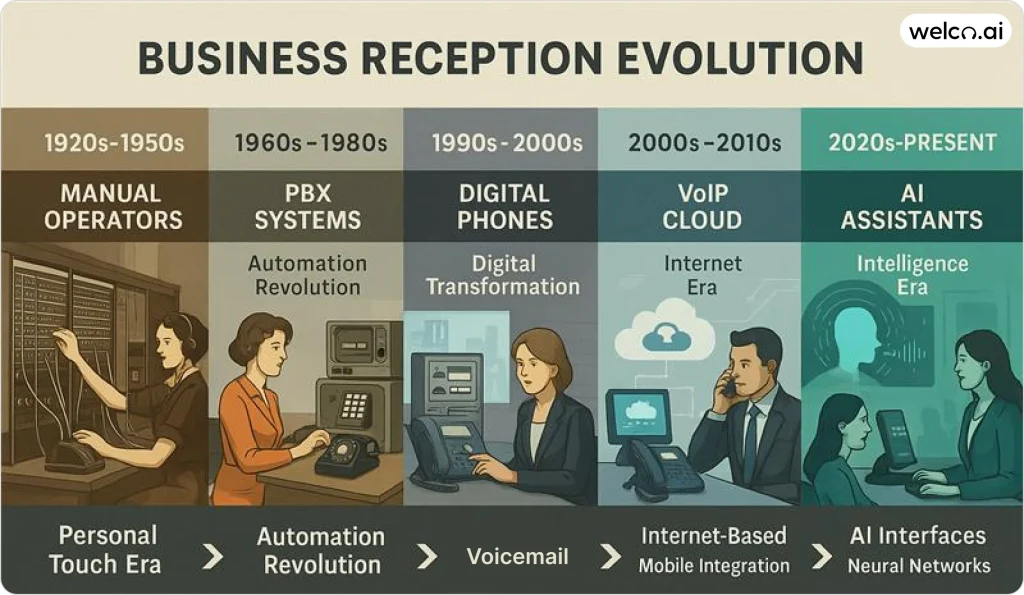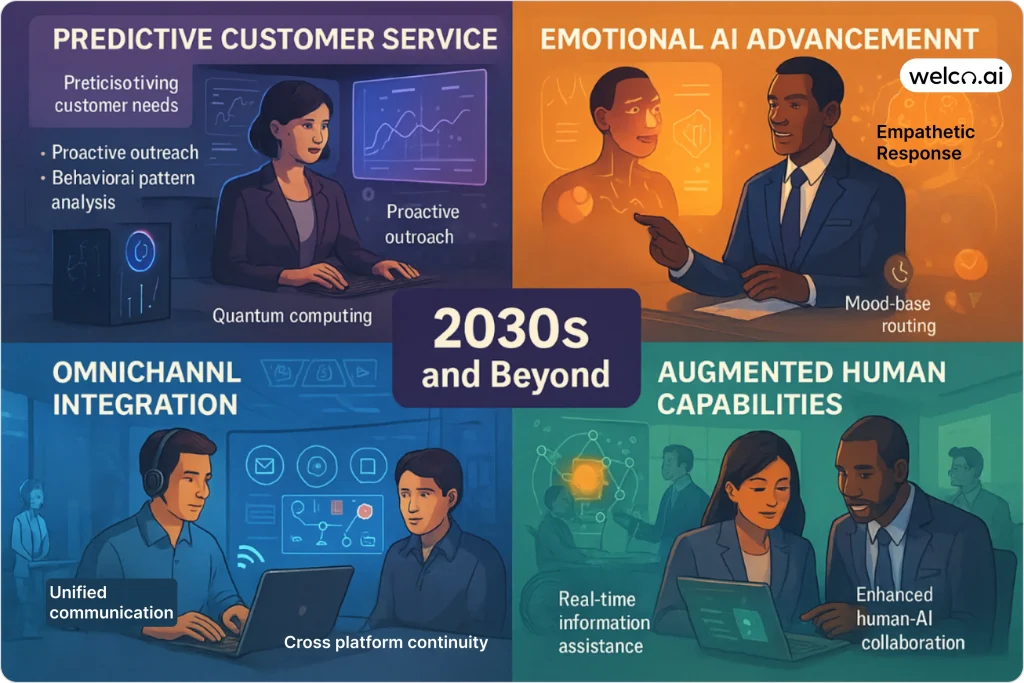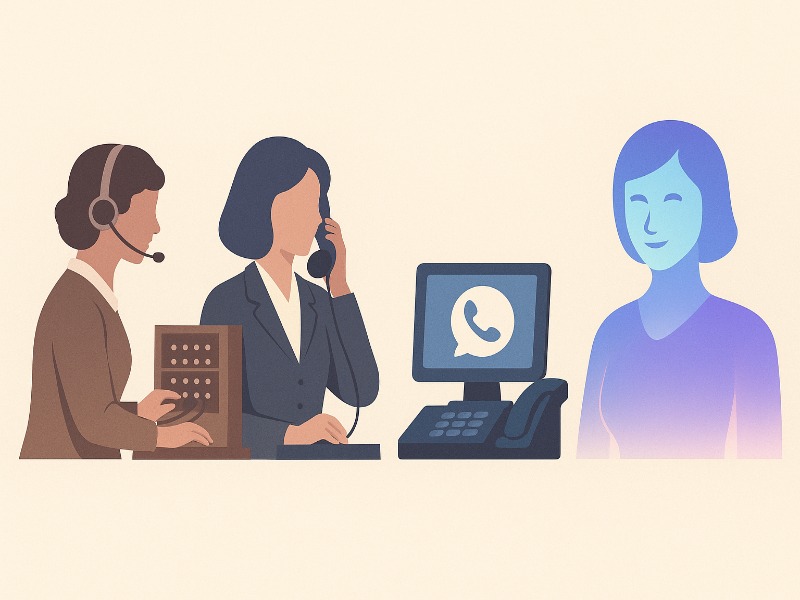
The Foundation Era: Manual Operators (1920s-1950s)
In the early 20th century, business telephone systems relied entirely on human switchboard operators. Companies employed dedicated telephone operators who manually connected every incoming and outgoing call using patch cords and mechanical telephone exchanges.
The Human Element
These telephone operators were typically well-trained women who became the voice and personality of their companies. They knew regular callers by voice, understood company hierarchies, and often served as informal gatekeepers who could make or break business relationships. This period represents the origins of modern business reception, where personal connection was paramount in commercial telephone systems.
Key Characteristics:
- Personal relationships with frequent callers
- Intimate knowledge of company operations
- Real-time call prioritization based on human judgment
- Complete dependence on operator availability
Business Impact
Manual operators created a highly personal customer experience but came with significant limitations. Companies with multiple operators needed complex coordination systems, and after-hours coverage was expensive or impossible for smaller businesses.
The personal touch came at a cost: high labor expenses, limited scalability, and complete service disruption when operators were unavailable. This challenge would drive the next major phase in business phone system evolution.
The Automation Revolution: PBX Systems (1960s-1980s)
The introduction of Private Branch Exchange (PBX) systems marked the first major technological shift in business phone systems. These mechanical and later electronic systems allowed callers to reach specific extensions directly, reducing reliance on human operators and transforming office communication history.
Technological Breakthrough
PBX systems introduced the concept of automated call routing. Callers could dial extension numbers directly, and the system would mechanically connect the call without human intervention. This innovation dramatically reduced labor costs while improving call completion rates.
Revolutionary Features:
- Direct extension dialing
- Internal call transfers
- Conference calling capabilities
- Basic call queuing systems
Cultural Shift
This era marked the beginning of self-service customer interactions in business telephone systems. Businesses had to balance efficiency gains with the loss of personal connection that human operators provided. Many companies maintained reception desks for greeting visitors while allowing direct phone access to departments.
The role of receptionists evolved from call connection to customer service, information provision, and administrative support—a transformation that would continue throughout telephone technology evolution. This period marked the beginning of human-AI collaboration models that we see emerging in today’s business environments.
The Digital Transformation: Advanced Phone Systems (1990s-2000s)
The 1990s brought computerized business phone systems that introduced features we now consider standard: voicemail, automated attendants, and sophisticated call routing based on time, caller ID, and departmental availability. This represented a major milestone in telephone system modernization.
Technological Sophistication
Digital systems could handle multiple simultaneous calls, provide detailed call analytics, and integrate with early computer systems. Interactive Voice Response (IVR) systems allowed callers to navigate menu options using their phone keypads.
Game-Changing Features:
- Voicemail systems for missed calls
- Automated attendants with menu options
- Call forwarding based on rules and schedules
- Integration with early CRM systems
- Detailed call reporting and analytics
Business Adaptation
Companies began designing their communication strategies around these new capabilities. The concept of “phone trees” emerged, allowing larger organizations to efficiently route calls to appropriate departments without human intervention.
However, this efficiency often came at the expense of customer experience. Many customers found themselves navigating complex menu systems that prioritized operational efficiency over user-friendliness—a challenge that would influence future developments in business communication evolution.
The Internet Era: VoIP and Cloud Communications (2000s-2010s)
Voice over Internet Protocol (VoIP) technology fundamentally changed business communications by transmitting voice calls over internet connections rather than traditional analog phone systems. This shift made advanced features affordable for businesses of all sizes and accelerated phone system modernization.
Democratization of Advanced Features
Features that were once exclusive to large enterprises with expensive PBX systems became accessible to small businesses through cloud-based VoIP services. Companies could now access sophisticated call management tools without significant upfront hardware investments.
Transformative Capabilities:
- Cloud-based systems with no on-premise hardware requirements
- Advanced call routing and queuing
- Integration with email and web-based applications
- Mobile app extensions for remote work
- Video conferencing integration
- Real-time collaboration tools
Operational Flexibility
VoIP systems enabled distributed workforces long before remote work became mainstream. Employees could answer business calls from anywhere with internet access, and companies could easily scale their communication systems up or down based on changing needs.
The traditional concept of a centralized reception desk began to evolve as businesses explored virtual reception models and distributed customer service approaches—setting the stage for the next phase in business phone evolution.
The Mobile Revolution: Smartphones and Apps (2010s)
The widespread adoption of smartphones created new expectations for business accessibility and responsiveness. Customers began expecting immediate responses across multiple communication channels, not just traditional phone calls. This era marked a significant shift in communication technology history.
Multi-Channel Communication
Businesses had to adapt to customers who might start a conversation via phone, continue it through email, and expect updates via text message. The role of business reception expanded beyond phone answering to comprehensive communication management, laying groundwork for modern omnichannel integration strategies.
New Expectations:
- 24/7 accessibility across multiple channels
- Immediate response times
- Seamless transitions between communication methods
- Mobile-optimized customer experiences
- Social media integration
The Always-On Business
Mobile technology created the expectation that businesses should be reachable at all times. Companies that couldn’t provide round-the-clock coverage began losing opportunities to competitors who could maintain constant accessibility.
This period saw the emergence of hybrid reception models combining human agents with automated systems to provide extended coverage without prohibitive costs—a precursor to modern AI-powered business phone systems.
The AI Era: Intelligent Virtual Assistants (2020s-Present)
The current evolution represents the most significant advancement since the introduction of automated systems. Modern AI receptionists can understand natural language, adapt to conversation context, and handle complex customer interactions that previously required human intelligence.
Beyond Automation to Intelligence
Unlike previous automated systems that followed rigid scripts, AI receptionists can understand intent, remember conversation context, and make intelligent decisions about call routing and response strategies.
Breakthrough Capabilities:
- Natural language processing for human-like conversations
- Emotional intelligence to detect caller mood and urgency
- Learning capabilities that improve performance over time
- Integration with comprehensive business systems
- Multilingual support with cultural adaptation
- Advanced security features including voice biometrics
The Human-AI Partnership
Rather than completely replacing human receptionists, AI systems are creating new hybrid models where artificial intelligence handles routine inquiries while escalating complex situations to human agents with complete context and conversation history.
This partnership allows businesses to provide 24/7 coverage while ensuring that complex or sensitive situations receive appropriate human attention.
Industry-Specific Evolution Patterns
Different industries have adapted reception technology at varying paces based on their specific needs and regulatory requirements.
Healthcare
Take Riverside Family Medical Center in Denver, Colorado, as an example of early adoption. Dr. Patricia Martinez implemented secure communication systems in 1995 due to HIPAA requirements, transitioning from manual appointment scheduling with handwritten logs to automated systems that could handle routine inquiries while ensuring patient privacy.
Modern healthcare reception systems can:
- Screen symptoms and route urgent calls appropriately
- Schedule appointments across multiple providers
- Send automated appointment reminders
- Handle prescription refill requests
- Maintain complete HIPAA compliance
Legal Services
Consider the example of Johnson & Associates, a mid-sized law firm in Atlanta, Georgia. Partners Sarah Johnson and Michael Chen traditionally relied heavily on their longtime receptionist, Mrs. Eleanor Davis, who worked there for 23 years and knew every client by voice. When Mrs. Davis retired in 2018, the firm faced a choice: hire and train new human staff or explore modern technology solutions.
The business communication evolution has been more gradual in legal services, with emphasis on maintaining personal relationships while adding efficiency.
Current legal reception systems focus on:
- Confidential client intake procedures
- Conflict checking before scheduling consultations
- Secure message handling for sensitive communications
- Integration with legal practice management systems
Real Estate
Miami-based Century 21 agent Carlos Rodriguez exemplifies the industry’s rapid technology adoption. In 2019, Carlos missed a $2.3 million luxury condo sale because a potential buyer called at 11 PM on a Sunday while he was with family. The next week, he implemented an AI phone system that captured three new leads during off-hours, including a $1.8 million waterfront property sale.
The telephone technology evolution has emphasized speed and accessibility, as timing often determines transaction success.
Modern real estate reception includes:
- Instant property information delivery
- Automated showing scheduling
- Lead qualification and routing
- Integration with MLS and CRM systems

Looking Forward: The Future of Business Reception
Several trends are shaping the next phase of business reception evolution:
Predictive Customer Service
AI systems are beginning to anticipate customer needs based on historical data, communication patterns, and external factors. Future reception systems may proactively reach out to customers before they even realize they need assistance, representing advanced predictive service capabilities that will transform customer relationships.
Omnichannel Integration
The lines between phone, email, chat, social media, and video communication continue to blur. Future reception systems will seamlessly manage customer relationships across all touchpoints with complete context preservation.
Emotional AI Advancement
Reception systems are becoming more sophisticated at understanding and responding to human emotions. This capability will enable more empathetic customer interactions while maintaining the efficiency benefits of automation, raising important considerations about AI ethics in customer communication.
Augmented Human Capabilities
Rather than replacing human receptionists, future systems will augment human capabilities with real-time information, suggested responses, and predictive insights that enhance the quality of human interactions. This evolution points toward comprehensive future workplace virtual assistance that seamlessly integrates human and artificial intelligence.
The Continuing Evolution
The evolution of business reception reflects broader trends in technology adoption, customer expectations, and business operations. Each technological advancement has solved previous limitations while creating new possibilities for customer engagement—a pattern evident throughout communication system history.
Key Patterns
Throughout this evolution, several consistent patterns emerge:
- Technology adoption follows business need: Companies adopt new reception technologies when they solve specific operational challenges
- Customer expectations drive innovation: Each generation of customers brings new expectations that push technological boundaries
- The human element remains valuable: Despite increasing automation, personal human connection continues to play a crucial role in business relationships
- Integration complexity increases: Modern systems must work seamlessly with an expanding ecosystem of business applications
The rise of mobile technology also introduced new opportunities for voice search and business discovery, fundamentally changing how customers find and interact with businesses.
Strategic Implications
Understanding this evolutionary pattern helps businesses make informed decisions about their communication strategies. The most successful companies have been those that embraced new technologies while preserving the human elements that matter most to their customers.
The future will likely continue this pattern, with AI and automation handling an increasing share of routine interactions while human expertise focuses on complex, high-value customer relationships—representing the next chapter in business reception evolution.

Conclusion: From Connection to Intelligence
The journey from manual telephone operators to AI-powered virtual assistants represents more than just technological progress—it reflects our evolving understanding of customer service, business efficiency, and human-machine collaboration throughout communication technology history.
Today’s business reception systems combine the efficiency of automation with the intelligence of AI and the irreplaceable value of human expertise. This hybrid approach enables businesses to provide consistent, high-quality customer experiences while operating more efficiently than ever before.
What’s Coming Next: The 2030s and Beyond
As we look toward the future, emerging technologies promise even more dramatic changes. Quantum computing will enable instant language translation with perfect cultural context. Brain-computer interfaces may allow direct thought-to-communication, revolutionizing accessibility for people with disabilities. Holographic receptionists could provide face-to-face interactions without physical presence, while predictive AI will anticipate customer needs before they even pick up the phone.
The evolution of business reception will continue to be driven by the fundamental goal that has remained constant throughout this journey: creating meaningful connections between businesses and their customers in the most efficient and effective way possible.
The companies that thrive will be those that understand this evolution not as a replacement of human capability, but as an enhancement of it—using technology to amplify what humans do best while automating what machines can do better.
The next chapter is being written now. Those who understand this century-long evolution will be best positioned to navigate the revolutionary changes ahead, ensuring their businesses remain at the forefront of customer communication excellence.
Frequently Asked Questions
Why did businesses move away from human telephone operators?
The transition from manual telephone operators occurred primarily due to scalability and cost challenges. As businesses grew and call volumes increased, maintaining multiple human operators became expensive and logistically complex. Operators required breaks, vacations, and after-hours coverage, leading to missed calls and inconsistent service. The introduction of PBX systems in the 1960s offered direct dialing capabilities that reduced labor costs by 60-80% while providing 24/7 availability. Additionally, human operators were prone to errors and personal biases, whereas automated systems provided consistent, reliable call routing regardless of time or circumstances.
How long did it take for businesses to fully adopt new phone technologies?
Historically, major phone technology adoption has taken 15-25 years for widespread business implementation. Manual operators dominated from the 1920s through the 1950s, while PBX systems gradually replaced them through the 1980s. Digital phone systems emerged in the 1990s but weren’t fully adopted until the 2000s. VoIP technology, introduced in the late 1990s, took nearly 20 years to become mainstream. However, modern adoption cycles are accelerating—cloud phone systems and AI receptionists are seeing faster implementation due to lower barriers to entry and immediate cost savings. Small businesses can now implement advanced phone systems in days rather than months.
What happened to all the telephone operators when automation took over?
The transition was gradual, allowing many telephone operators to retrain for other roles. As direct dialing reduced the need for call connection, operators evolved into customer service representatives, administrative assistants, and information specialists. Many telephone companies retrained their operators for new positions in sales, technical support, and business operations. The skills that made good operators—clear communication, patience, and problem-solving—translated well to these emerging roles. Some operators became trainers for the new automated systems or supervisors in expanding customer service departments. The transition occurred over decades, providing time for workforce adaptation rather than sudden unemployment.
Are there any disadvantages to modern automated phone systems compared to human receptionists?
While modern phone systems offer significant advantages, they do have limitations. Automated systems can struggle with complex, nuanced conversations that require empathy, creativity, or deep product knowledge. They may frustrate customers who prefer human interaction or have unique requests outside programmed parameters. Cultural and language nuances can be challenging for AI systems, potentially leading to misunderstandings. Additionally, technical failures can completely disable automated systems, whereas human operators could continue working during power outages. However, modern AI receptionists are addressing many of these limitations through natural language processing, emotion recognition, and intelligent escalation to human agents when needed.
How can businesses choose the right phone system for their current needs?
Selecting the appropriate phone system depends on several key factors: business size, call volume, budget, and growth plans. Small businesses with under 50 employees often benefit from cloud-based VoIP systems that offer enterprise features without high upfront costs. Medium businesses may need hybrid solutions combining automated systems with human support. Consider your industry requirements—healthcare needs HIPAA compliance, legal firms require confidentiality features, and retail businesses need integration with point-of-sale systems. Evaluate current pain points: if you’re missing calls, need 24/7 coverage, or want to reduce reception costs, AI systems may be ideal. Always start with a pilot program to test effectiveness before full implementation.
